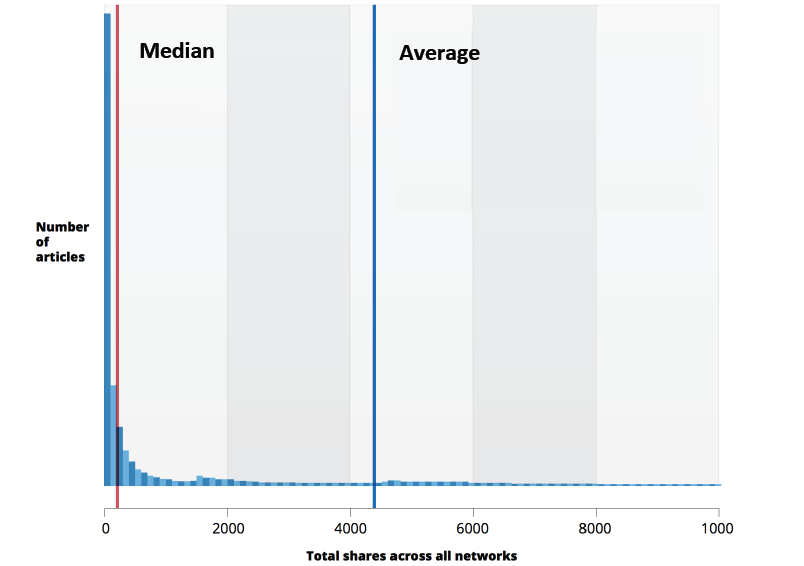 Last month, I participated in the Moz webinar “Why People Share and Link: Content’s Footprint”, presented by Steve Rayson from Buzzsumo.
Last month, I participated in the Moz webinar “Why People Share and Link: Content’s Footprint”, presented by Steve Rayson from Buzzsumo.
Steve’s presentation went through a research study that he conducted that attempted to answer the question, “Why do people share and link?” To determine the answer to this question, Steve pooled together three samples groups (100k random posts, 670k well shared posts with different formats, 350k post from with high correlation between shares and links) of nearly one million posts to analyze. The number of shares and links of these articles generate help us determine the factors that contribute to the post’s success.
I found the conclusions from this study to be highly relevant for B2B marketers and content creators. I will discuss the three findings Steve presented and how to implement these concepts into a content creation strategy. Here are the findings:
1. Well Researched Content
I. This point comments on the fact that content that refers to credible and authoritative research receives a much better reception from readers. Content backed by research makes readers confident about sharing and linking to your content, which results in the likelihood of generating more shares and likes.
II. In the B2B world where content is abundant, it can sometimes be a challenge to write well researched content. Especially with the limited amount of time and the need to keep up with the quick turn over of pumping out content, this can seem daunting. Especially when the alternative to a research backed piece of content is an acceptable and often successful post such as a quick listicle. The problem however, as Steve puts it, is that listicles are often recycled or an aggregation of ideas. Instead, consider conducting primary research and report on your findings. People are interested in finding new insights, and therefore more likely to share or link to your content.
2. Quality Opinion Content
I. In Steve’s research he looked at journalistic domains and their most successful posts to see what types of articles got the most share and links. From this part of the research, he concluded that opinion based content got the most shares and links. Opinion based content are articles and posts that express an emotion or a particular view point.
II. Jumping of the first point, this finding also relies on the principle that content is likely to be amplified more if it expresses a new or opinion driven, idea. Personally, I appreciate and am more interested in learning about different opinions and perspectives. Especially in the world of B2B marketing, where things are progressing at a rapid rate, consider crafting content on relevant and timely events. Don’t stray away from putting out a controversial or even un-popular notion, if you believe in it.
3. Long Form Content
I. Steve’s research also concluded that long-form content performs much better in both shares and links. The research indicates for up to 3000 words shares and links increased as number of words increased. After 3000 words the data flattens out.
II. Time is valuable so writing a long form post can be difficult. However, writing quality long form posts can make a huge different in how your content is received. In addition to potentially increased shares and links, long form posts also increase user time on site and higher rankings in search results.
In combination, the three findings from Steve’s research boils down to creating comprehensive content. Insightful and thought provoking content that is opinion based and backed by research is what makes shareable content. This may be a tall order for many businesses, but the results time and time again suggest that this formula works.
Below I’ve outlined two additional insights that I found to be particularly compelling.
BONUS INSIGHTS
1. It’s difficult to see a high correlation between shares and links
A piece of content that gets a bunch of shares will not necessary have a high amount of links. Steve attributes this to different formats of content producing different results. For example, a research based white paper may generate more domain links, for being authoritative and credible, but perhaps not as many shares. On the other hand,a fun quiz may get more shares than links. The takeaway for me in regards to this point, is the importance of crafting content for specific purposes. It’s important to consider the goal of a particular piece of content when producing it.
2. Averages Don’t Mean Anything
The chart below outlines the number of articles versus the number of shares of a sample of posts. The average line (blue), indicates that the average amount of shares is over 4000 per article. It is a daunting number to consider as a bench mark, The median (red) on the other hand is very close to 0. This means that 50% of shares from articles get less than the median number.
As content creators, we are continually analyzing what we produce to try to better our craft. In this analysis phase, its easy to get bogged down with numbers. To really reflect on how content performs, it’s important to look at the right data to produce insights that are truly meaningful in relational to your content.

In conclusion, Steve’s research outlined a number of helpful insights. I found the suggestions to be easy to understand and highly applicable if you’re developing a Marketing Strategy.
Sign up a Moz community member to get access to this webinar and other archived webinars.
If you’re interested in discussing how to develop your marketing strategy feel free to contact us or send us a tweet.
